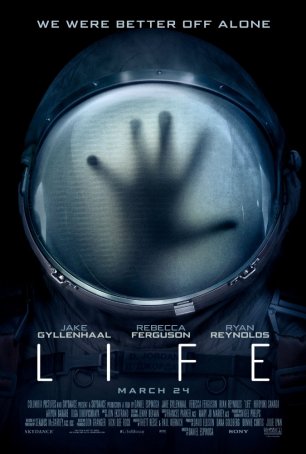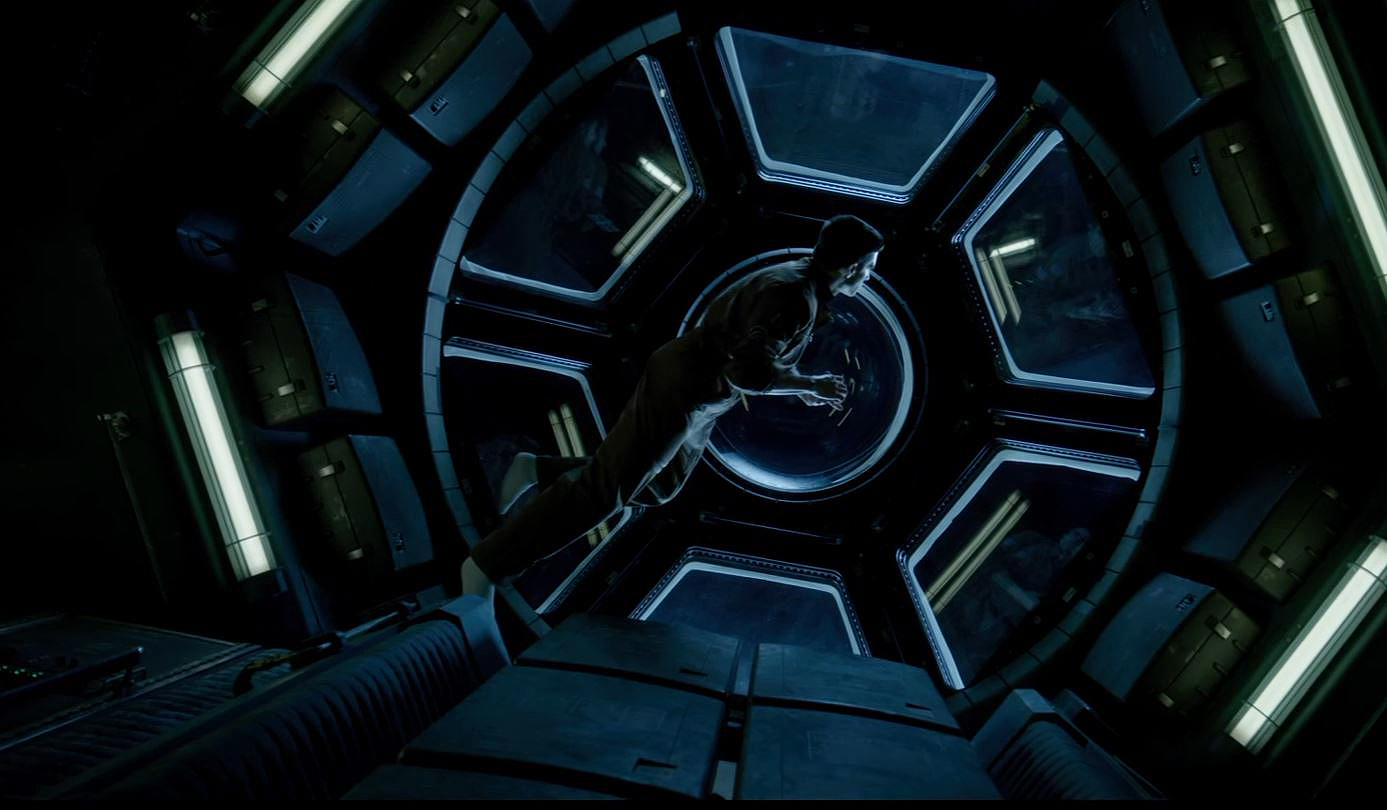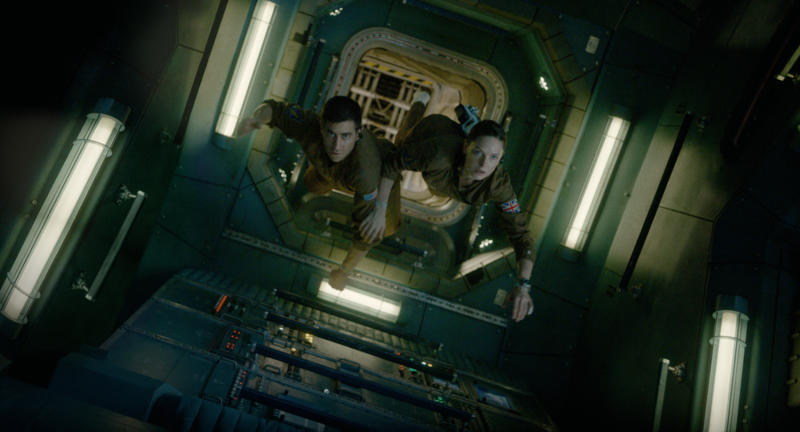Life | Reelviews Movie Reviews (original) (raw)
Life (United States, 2017)
March 24, 2017

Oblique spoilers follow. Nothing specific, but there are some hints about things perhaps better left unrevealed.
Yes, for a majority of its running length, Life is an Alien clone. The similarities are so strong that they’re impossible to ignore. However, while Ridley Scott’s 1979 classic has provided a template for countless films over the nearly 40 years since its unveiling, few have been as effective as Daniel Espinosa’s version. The director does nothing to hide his movie’s inspiration (several scenes include obvious references) but, armed with a script credited to Rhett Reese and Paul Wernick, he uncovers a way for Life to divest itself from its cinematic heritage. Those who have seen _Alien_will have a pretty good idea what’s coming, at least to a point. Once things reach that point, however, all bets are off. Just don’t expect this to be a light, escapist excursion into outer space. Even by sci-fi/horror standards, this is dark, gruesome, intense stuff. Not for the faint of heart or those who crave happy endings.
Perhaps the best thing about Life is that, when it’s being a science fiction film, it’s a good science fiction film and, when it’s being a horror film, it’s a good horror film. The wedding of the two is uneven. Fans of more cerebral movies might be put off by the degree to which Espinosa celebrates the Grand Guignol. And lovers of gore and viscera might find some of the scientific and existential minutia to be tiresome. In general, however, Espinosa manages the seemingly impossible feat of at times echoing Stanley Kubrick and Ridley Scott.
 To be clear, those echoes of Scott are faint. Life, although capable of causing heart palpitations, is nowhere near as intense as Alien. The atmosphere isn’t as strong and the suffocating growth of tension isn’t as overpowering. And the Kubickian moments are fleeting – CGI-created shots of Earth below and the stars above. There’s majesty in some of these moments but Life is much more about what transpires within the cramped confines of the International Space Station than it is about what’s going on outside.
To be clear, those echoes of Scott are faint. Life, although capable of causing heart palpitations, is nowhere near as intense as Alien. The atmosphere isn’t as strong and the suffocating growth of tension isn’t as overpowering. And the Kubickian moments are fleeting – CGI-created shots of Earth below and the stars above. There’s majesty in some of these moments but Life is much more about what transpires within the cramped confines of the International Space Station than it is about what’s going on outside.
The film follows the tribulations of the crew of six manning the station with the sole purpose of investigating Martian soil samples provided by a capsule that has returned from the Red Planet. Reflecting the “International” nature of the station, the mission specialists hail from four countries: the U.S. (Rory Adams, played by Ryan Reynolds, and Doctor David Jordan, played by Jake Gyllenhaal), the U.K. (Quarantine Expert Miranda North, played by Rebecca Ferguson, and biologist Hugh Derry, played by Ariyon Bakare), Russia (Commander Katerina Golovkin, played by Olga Dihovichnaya), and Japan (Sho Kendo, played by Hiroyuki Sanda). When they discover signs of life in the dirt, they nurse it out of suspended animation and give it a name (“Calvin”). Their delight at seeing “Calvin” grow and develop turns to alarm when it shows violent tendencies and displays surprising strength and intelligence. When procedures to keep it contained prove inadequate, the mission turns into a fight for life: six humans against one extraterrestrial, with the understanding that, to keep the creature from reaching Earth, all lives are expendable.
 Although the beats of the movie are predictable, the specific notes aren’t. We’ve seen this kind of cat-and-mouse game before but _Life_’s characters are sufficiently developed that this doesn’t seem like the usual horror routine of “guess who dies next.” The filmmakers mine suspense from the situation while not being afraid to makes some daring choices. Espinosa establishes a serious tone (at times reminiscent of Solaris) – this doesn’t feel like a campy retread and the caliber of the actors is at a sufficiently high level that we can accept it. Jake Gyllenhaal is his usual, reliable self and, although this isn’t a tour de force for him, he provides a character we can relate to. Ryan Reynolds puts aside his jokey Deadpool personality to play it straight. The other four, although not as well-known, are equally solid.
Although the beats of the movie are predictable, the specific notes aren’t. We’ve seen this kind of cat-and-mouse game before but _Life_’s characters are sufficiently developed that this doesn’t seem like the usual horror routine of “guess who dies next.” The filmmakers mine suspense from the situation while not being afraid to makes some daring choices. Espinosa establishes a serious tone (at times reminiscent of Solaris) – this doesn’t feel like a campy retread and the caliber of the actors is at a sufficiently high level that we can accept it. Jake Gyllenhaal is his usual, reliable self and, although this isn’t a tour de force for him, he provides a character we can relate to. Ryan Reynolds puts aside his jokey Deadpool personality to play it straight. The other four, although not as well-known, are equally solid.
Special effects and set design are top-notch. The outside sequences are limited but realistic and the inside scenes are suitably claustrophobic. Creature design varies significantly from the Alien prototype we normally encounter, although its ready-for-dinner mouth may cause a moment or two of déjà vu. Jon Ekstrand’s discordant score adds to the darkness without becoming overbearing.
By its nature, it’s hard to see Life being a big box office player. Audiences tend to avoid films that offer intensity over triumph and take chances that viewers might dislike. Horror fans in general are more accepting of this sort of thing so Life should do fine with that audience. The movie certainly doesn’t skimp on blood and gore – the dissolution of a white lab rat may be the most disturbingly graphic scene of the year. Despite its heavy linkage to Alien, this movie feels strangely fresh, perhaps because it refuses to play things safe in order to placate audiences who don’t like to be upset or challenged. Anyone who’s up for something ominous and unsettling could do worse than to choose Life.
